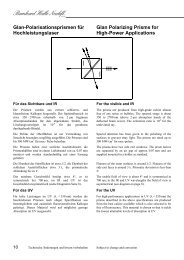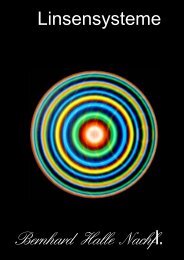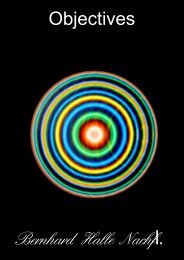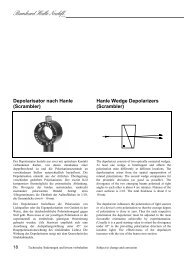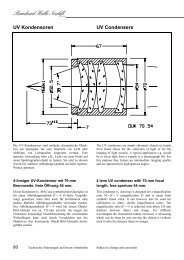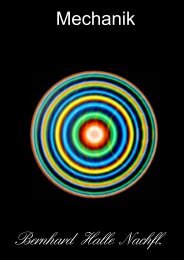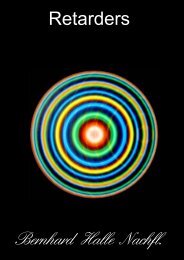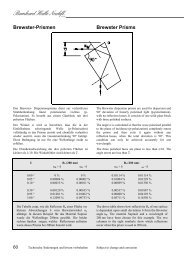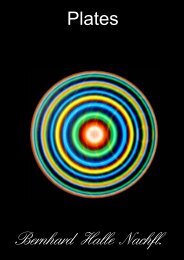Wollaston- und Rochon - Bernhard Halle
Wollaston- und Rochon - Bernhard Halle
Wollaston- und Rochon - Bernhard Halle
Erfolgreiche ePaper selbst erstellen
Machen Sie aus Ihren PDF Publikationen ein blätterbares Flipbook mit unserer einzigartigen Google optimierten e-Paper Software.
<strong>Bernhard</strong> <strong>Halle</strong> Nachfl.<br />
GmbH<br />
UV-VIS-IR-Apochromate UV-VIS-IR Apochromats<br />
Polarisationserhaltend durch ausschließlich<br />
isotrope Linsen-Materialien<br />
Diese Objektive, die auch als UV-Achromate bezeichnet<br />
werden können, sind aus Quarzglas <strong>und</strong> CaF2 gefertigt. Die<br />
Objektive werden für unendliche Objektentfernung (Abbildungsmaßstab<br />
β' = 0) bzw. für 1:1-Abbildung (β' = -1)<br />
gefertigt.<br />
Durch den Einsatz neuer Konstruktions-Techniken <strong>und</strong><br />
-Hilfsmittel ist es uns möglich geworden, in diesen UV-<br />
Achromaten den bisher verwendeten doppelbrechenden <strong>und</strong><br />
optisch aktiven Quarzkristall durch isotropes Quarzglas zu<br />
ersetzen ohne die Abbildungsqualität zu beeinträchtigen.<br />
Dadurch sind die Objektive jetzt auch für Anwendungen<br />
geeignet, in denen es auf die Erhaltung der Polarisation<br />
ankommt. Die Umstellung ist noch nicht für alle Typen<br />
abgeschlossen, so dass in einer Übergangszeit auch noch<br />
Systeme mit Linsen aus Quarzkristall ausgeliefert werden.<br />
Auf Anfrage bieten wir Ihnen wenn möglich Linsen aus<br />
dem Material Ihrer Wahl an.<br />
Die Transmission der Materialien macht eine Anwendung<br />
im Wellenlängenbereich von ca. 180 nm bis zu 2,5 µm<br />
möglich. Die chromatische Korrektur ist achromatisch im<br />
UV <strong>und</strong> apochromatisch im Wellenlängenbereich von<br />
190 nm bis über 1,2 µm (UV-VIS-IR), die chromatische<br />
Schnittweiten-Änderung (bei ß’=0) beträgt in diesem<br />
Bereich bis zu 0,8% der Brennweite. Zwischen 200 nm <strong>und</strong><br />
340 nm liegt die Änderung bei 0,3% bis 0,4% der<br />
Brennweite.<br />
Bei optimaler Fokussierung sind die Objektive für<br />
Bildpunkte nahe der Achse beugungsbegrenzt, im Bildfeld<br />
(bis zu einigen Grad Bildwinkel) können Bildfeld-Wölbung<br />
<strong>und</strong> Astigmatismus wegen der im UV stark eingeschränkten<br />
Auswahl an Linsen-Materialien <strong>und</strong> der geringen Linsenzahl<br />
nicht ganz auskorrigiert werden.<br />
Polarization preserving by use of purely<br />
isotropic lens materials<br />
These objectives which can be described as UV achromats<br />
too are produced from fused silica and CaF2. The objectives<br />
are manufactured either for one infinite conjugate<br />
(magnification ratio β' =M= 0) or for 1:1-imaging<br />
(β' = M= -1).<br />
The use of new construction techniques and tools made it<br />
possible to replace the previously used birefringent and<br />
optically active crystal quartz by isotropic fused silica<br />
without a reduction of the imaging quality. Therefore, these<br />
objectives are now suitable for applications in which the<br />
preservation of the polarization orientation is crucial. The<br />
conversion is not yet finished for all models and for some<br />
time some systems will still be delivered with crystal quartz<br />
lenses. If you require a particular lens material we shall on<br />
your request gladly send you a corresponding quotation if a<br />
suitable system is available.<br />
The transmission of the materials makes these objectives<br />
suitable for use in the wavelength region from approx.<br />
180 nm up to 2.5 µm. The chromatic correction is<br />
achromatic in the UV and apochromatic in the wavelength<br />
range from 190 nm to above 1,2 µm (UV-VIS-IR), in this<br />
range the chromatic variation of back focal length (at M=0)<br />
is up to 0.8% of the focal length. Between 200 nm and<br />
340 nm the variation amounts to 0.3% to 0.4% of the focal<br />
length.<br />
When optimally focused then the objectives are diffraction<br />
limited for image points close to the optical axis. For finite<br />
fields (up to a few degrees image angle) it is not possible to<br />
correct for field curvature and astigmatism completely due<br />
to the limited choice of UV lens materials and by the<br />
limited number of lenses.<br />
84 Technische Änderungen <strong>und</strong> Irrtum vorbehalten Subject to change and correction



